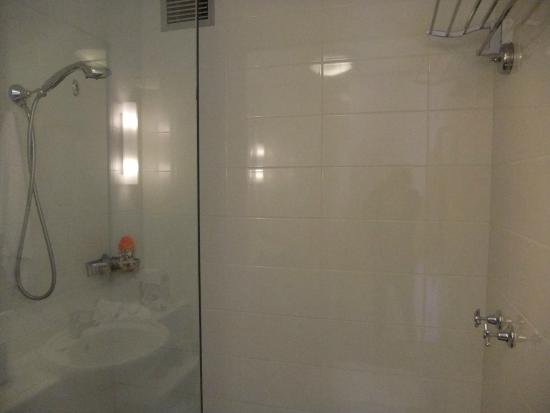It may be a somewhat odd question, but can your shower controls be on the opposite wall from your faucet or showerhead? Though it may be different than most bathroom setups, having your controls and showerhead on opposite ends has its own advantages and drawbacks.
You may be wondering if setting up your shower in this manner will create any problems with code enforcement and what type of possible plumbing issues it can help you avoid. Not to mention the unique style statement you make by installing your controls in this manner.
This article dives headfirst into shower controls installed opposite of your showerhead. We will cover the benefits and drawbacks of having your shower controls set up this way and go over things you should consider before committing to this setup.

The Pros and Cons of Having Shower Controls on the Opposite Wall
Pros
You Won’t Get Wet Beforehand
A common benefit of having your shower set up this way is you can turn on your shower and adjust the temperature without getting wet. This is especially helpful if you’re setting up a shower for someone else, like a young child.
Stylistic Appeal
By installing your controls on the opposite end of your showerhead, you make a stylish statement that some people find quite appealing. When compared to a traditional shower setup, this unique look can definitely set you apart.
Inexpensive
It may be surprising to hear but installing your controls opposite of your shower is quite inexpensive. Besides labor, the material cost is for the additional plumbing to reach from your showerhead to the opposite wall.
Easy to Install
Unexpectedly, this type of setup has a relatively easy installation process that only requires you to extend your plumbing in the opposite direction. The most difficult part of the process will be cutting the hole in your wall for the new placement of your shower controls.
Cons
A Lot of Back and Forth
Sometimes we need to adjust the temperature of our water while we are showering. This means you will be walking back and forth from your controls to your showerhead. This issue will be even more noticeable if you have a large walk-in shower.
Adjustment Period
If you have lived your entire life with your controls underneath your showerhead, you definitely have to go through an adjustment period. You will likely find yourself reaching for controls that aren’t there more than a few times before you get used to your new setup.
May Conflict With Other Plumbing
One major issue is you may find your opposite setup might conflict with other plumbing in the home. For example, a downstairs bathroom might have plumbing on only one wall for a reason because the opposite wall has plumbing that’s running upstairs.
Extra Work
While installing controls opposite of your showerhead may be easy and inexpensive, it still requires extra work and time if your shower controls are already underneath your showerhead. Some may consider the process unnecessary.
Things to Consider When Putting the Showerhead and Shower Valve on Opposite Walls
Climate Conditions
Depending on how cold the climate is in your area, you will want to be careful when placing plumbing on certain walls.
If the wall opposite the wall you’re placing your controls is an exterior wall, you may run into issues in the future. If you are in a warm area where it does not snow, you shouldn’t have any problems, but your pipes may freeze if you live in a more frigid climate.
Slipping Hazard
Whenever you are walking more than you have to on a wet slippery surface, you will have a greater chance of falling. With your controls on the opposite end, you will have to do a little extra walking to adjust or turn off your shower.
There are ways to mitigate this slipping hazard by using a slip-free shower mat or thermostatic valve, but they will not make your shower slip-free.
Previous Plumbing Installation
One issue you may run into when installing an opposite control setup is the plumbing already installed in your home. This may force you to place your controls off-center or in other awkward positions.
If you have extensive plumbing or electrical systems running through your opposite wall, this setup may not be feasible.
Thermostatic Valve
A thermostatic valve is a popular product that allows you to set your water to a certain temperature, and it will remain that way year-round, as long as you have hot water in your tank.
This reduces slipping and saves time by allowing you to set it and forget it. One downside of these products is they can be expensive and somewhat difficult to install.
FAQ
There is no code regulation against having your control valve and showerhead on opposite ends. But you do need at least 4 feet of distance between them to help with water pressure and general water flow. But if they are on the same wall, they only need around 30 inches.
You can run your shower’s plumbing on an exterior wall in some cases. It will depend on the climate where you live. If winter lows reach 32 degrees Fahrenheit or lower, you run the risk of freezing pipes.

